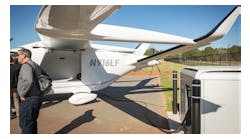As with every other industry, technology is changing the airport experience, from passenger amenities to airline logistics. As sensors, connected devices and intelligent data analytics become part of everything we do and everywhere we go, airports have opportunities to improve travelers’ experiences and streamline operations with access to real-time data and the promise of the Internet of Things (IoT).
According to SITA’s 2016 Airport IT Trends Survey, 75 percent of airports globally will have incorporated IoT into their strategy by 2019. IoT can improve multiple aspects of an airport, such as by regulating traffic flow and helping passengers navigate using Wi-Fi, beacons, NFC tags and geolocation; streamlining security checkpoints with biometrics like facial recognition; and reducing the number of lost bags using electronic luggage tags and sensors – and more. This adds up to cost and energy savings, more efficient day-to-day operations, increased personalization and happier, less stressed travelers – adding significant value for airports.
With the cost of sensors and data storage falling, more airports will begin adopting IoT applications. This push toward IoT has many airports taking a closer look at the technology factor that will drive everything else: their in-building wireless system, and whether it’s ready for the future.
Connectivity: What IoT Needs to Succeed
In very general terms, the IoT chain has four components: a device and its data, connectivity, analytics and management, working in what Deloitte calls the IoT information loop. Sensors create information about a physical event or state; the originating object communicates the information to others over a network; the network aggregates different pieces of information to others over a network; the network applies standards to analyze phenomena for patterns, relationships or anomalies; and the resulting analysis is a basic on which augmented intelligence can decide to act.
So, for example, in an airport, a bag with a connectivity-enabled electronic luggage tag that is coming off a plane and moving toward a baggage carousel can communicate with the passenger’s mobile device via wireless network and sense where in baggage claim the passenger is standing. The tag then pings sensors around the baggage claim area, allowing the sensors and tag to exchange and analyze location data, with the machinery making a decision to direct the bag to the carousel nearest the passenger.
That’s just one simple example to illustrate the way IoT works in an airport – but none of this data can be sent or received without constant, high-bandwidth connectivity that supports real-time data flow from hundreds and even thousands of devices and sensors living on the network. Without the layer of connectivity, IoT can’t exist.
This will create a challenge for airports using legacy Wi-Fi or other older wireless systems. Any airport that wants to get serious about incorporating IoT into its current and future offerings will need a powerful in-building wireless network that works both now and in the future.
DAS: The Network for the Future
A distributed antenna system (DAS) can solve an airport’s current needs as well as position it to take advantage of the technologies of tomorrow.
A DAS typically comprises active electronics, usually a central hub connected to remote units paired with antennas distributed throughout a building, with cabling interconnecting the elements. The central hub is connected to an RF source (usually a small cell or base station), which supplies the cellular signal.
Because the signal used to support a DAS is separate from outdoor cellular towers (except in rare instances where a repeater is used as the RF source), the added capacity is dedicated to the building – unlike for users of repeaters, which siphon capacity away from the outdoor towers. And because it’s an operator-approved and -supported cellular signal that’s being brought into the building, users receive a guaranteed level of service, as opposed to unguaranteed performance of voice-over-WiFi, for example.
Not all DAS solutions are created equal, however, and for an airport to ensure it chooses an IoT-ready DAS platform, there are several key components to look for:
An optimized network should:
- Facilitate the ways airport employees and travelers prefer to communicate now – via mobile devices and cellular connectivity
- Support all carriers from day one, to give access to everyone in the entire airport, no matter what carrier they use
- Access all of the most commonly utilized cellular and public safety signals as well as all of the frequencies available between 150 MHz and 2700 MHz on a single hardware layer, thus providing full spectrum connectivity
- Be ready and equipped to meet employees’ and travelers’ future connectivity and communication requirements without expensive or disruptive upgrades
- Use a simple, cost-effective, “one-and-done” approach to hardware installation, with the single original hardware layer able to support all carriers and frequency bands, as well as new connectivity requirements in the future, without additional hardware
- Be fiber based, instead of coaxial cable based or a hybrid of cable and fiber, to ensure optimal performance, as well as to keep costs lower and minimize installation time by using a building’s existing fiber infrastructure
- Support emerging technologies like IoT as well machine-to-machine (M2M) communications and 5G cellular – all of which require stable and reliable cellular connectivity
These critical traits will provide an airport with a best-in-class network that is IoT- and future-ready – and, importantly, will provide a reasonable, simple way to scale for future IoT capabilities that might still be but a twinkle in an engineer’s eye.
However, paying for the right system remains a pain point for many airports – and some may be reluctant to embark on their own IoT adventure because they fear the costs associated with a wireless upgrade and the investment in sensors and devices. While 71 percent of airport CIOs saw their budgets increase from 2015 to 2016, some may prefer to spend this surplus on the cybersecurity features that were the main budget priority in 2016, according to SITA.
But airports actually can get both security and connectivity out of the same piggybank. A new business model provides a way to help airports finance a quality DAS system and prepare for IoT and coming technologies: cellular-as-a-service (CaaS).
CaaS: A New Business Model
CaaS takes the same long-accepted business model of outsourcing technologies – think of cloud storage, and software as a service (SaaS) apps from companies like Salesforce and Microsoft – and revamps it for the in-building wireless space.
Many airports want to provide better connectivity to travelers and employees and incorporate more advanced IoT devices, but don’t want to get involved to the point of having to staff an entire IT department of RF experts who can manage the wireless in-house; the “set it and forget it” approach is usually more attractive. Additionally, an airport may not want to buy the infrastructure outright, which involves a lot of capital outlay.
Now, with a CaaS option, improved connectivity becomes an operational expense – just like paying the utility bills every month – removing the concerns about high upfront costs, as well as recurring downstream costs due to system changes and additions.
In the CaaS model, the solution is offered on a monthly, per-square-foot basis and includes deployment and ongoing system monitoring and maintenance. Any new frequency or operator additions on the system or additional coverage areas would not require the airport make additional capital outlays; they would be covered as part of the service.
This means an airport can depend on a reliable third party to manage the in-building wireless. The system is supported by industry-accepted service-level agreements as part of the ongoing monitoring of the solution, ensuring an expected level of service every day, much like paying a utility bill creates the expectation that the lights always turn on.
This alternative business model that will allow airports to check every box on their in-building wireless system wish list, getting a true IoT-ready system by paying for it with an operational expenditure (Opex) model, not a capital expenditure (Capex) model.
Prepping for the Future
According to GE, “Among airlines that have started experimenting with IoT, there are projects to improve passenger experience, baggage handling, tracking pets in transit, equipment monitoring, and generating fuel efficiencies. However, in an industry still struggling with integration across legacy systems, [CIOs] face challenges in getting the underlying architecture right as well as addressing security issues.”
While adding IoT capabilities to airports has the potential to transform the sector, IoT needs a strong backbone: a robust, reliable in-building network that can take on not just the challenges of IoT, but also anything the future may hold. A DAS that can meet an airport’s needs must be future-ready – but with the issue of cost constantly looming overhead, an airport may feel it is not able to invest in the DAS of its choice.
Now, with CaaS offering a new business model – paying for an in-building wireless system as a utility – airports have a broader range of options, allowing operations managers to make decisions today that prepare them for the future, and giving leadership confidence that the choice they make today will still be the right choice down the road.
Scott Willis is president and CEO of Zinwave. Willis can be reached at [email protected].





